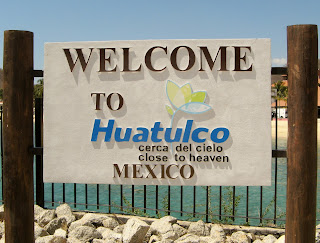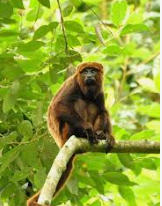We spent the
entire day yesterday immersed in the Mocha culture of northern Peru.
Before I get
into that though, I want to report that we sailed by pods of dolphins on the
way down the coast. We were too far away to see any individual dolphins but
that is what the captain said they were.
Fifty to a hundred dolphins formed a
mass of black, roiling water several hundred feet off our starboard side. You
could see the splashes when they jumped in the air, which is their dance of
joy, or their call to dinner. We saw flocks of brown boobies flying above them;
swooping down on the fish the dolphins stirred up.
Speaking of
the coast of Peru, it is dry and reminded me of the Half Moon Bay area of
California. They grow asparagus and artichokes, the same as Half Moon Bay. In
fact, they produce most of the asparagus that we eat in the U.S., including the
white asparagus.
There are rolling hills covered with miles of asparagus fields
all along the northern coast. The fields stand out bright green on the brown
hills. Ice plant is a common ground planting. Ice plant was everywhere in the
San Francisco Bay Area so it looked a lot like home to me.
Historians
speculate that the area suffers from an El Nino weather pattern which causes
either drought or floods. The local people were aware that they were at the
mercy of the whims of nature so the theory is that they tried to control it
through human sacrifice.
Unlike Nuku Hiva, there was nothing personal about these murders. It was like an assembly
line. Of course, if they could get a hold of some enemies, that was good. But,
it was really just a numbers game. The Sun apparently needed 100 sacrificial
victims a day or it would not rise in the morning. Also, it was necessary to
throw in some more victims to insure that the crops would grow.
It’s
understandable how this need for sacrifice grew into a cottage industry and
became highly organized. Yesterday, we visited Huaca del Sol and Huaca de la
Luna, the Temples of the Sun and the Moon. The Temples of the Moon were built
first so that area was much more developed.
The
archeological digs didn’t really get going until after 1990. The Huaca de la
Luna was built in five layers but the Spaniards took off the top layer looking
for gold in the 1500’s. They found gold in the form of ceremonials objects and
garments. No one knows how much they found as they melted down the artifacts
and shipped them back to Spain.
The looters
were not as interested in the other artifacts so many of them still survive to
show how the culture developed over the centuries. They favored a certain kind
of pottery and many examples were on display in the University Museum but we were
forbidden to take pictures.
I could have
bought something to bring home but I forgot my purse with all our money in it.
I was in a rush to publish my current blog before we got off the ship in the
morning and totally spaced it. I had to run back the ship when we returned and
grab some money for the tour guide.
Our guide was
Alfredo Rios Mercedes and he gave us a bang up tour of the area. We were on a
wonderful bus with a driver so Alfredo lectured all day and answered questions.
As usual, we asked about education. It’s mandatory but the students were on
vacation. Winter break starts in mid-December and lasts until March 1. So we
saw a lot of children wherever we went.
I asked for the local consensus about
America. It wasn’t enthusiastic but not too guarded. He said they like Obama
more than Bush, but again, not a glowing recommendation.
I took 300
pictures yesterday. It took a couple of hours to organize them when we got back
to the ship.
We were beat. Bill made it all the way to the top of the Temple of
the Moon. We took his walker. People on the tour carried it up the different
flights of stairs. We held onto each other and managed to struggle slowly to
the top. As you can imagine, he stayed on the bus after that.
After the
Temples, we visited Trujillo city. We visited the main buildings around the Plaza
del Armas. We saw some restored houses that are now owned by local banks. They
were called the Urquaiga and Emancipation Houses. So, people were lined up
outside to do banking business but they let us past the locked gate to take
pictures of the courtyards and the house section.
I took a picture of the Simon
Bolivar’s bedroom.
We also
visited another Cathedral called San Francisco. I accidentally set my camera on
Portrait and all those pictures were lost but it looked like most cathedrals in
Spain.
Next, we went
to see the Citadel of Chan Chan. Chan Chan means Sun Sun. This is the culture
of the people who succeeded the Mohicans. These excavations are also recent so
only one of the 17 huge temples is even partly excavated and restored. Before
this excavation, they just looked like hills of sand. No one really knew what
was under the sand until they uncovered some of it.
They were
still dedicated to human sacrifice but organized it differently.
You will have
to wait for the pictures to see how they set up their public squares. It was
highly geometrical. We saw only one set of circles during our walk. They did
not use the wheel except in children’s toys. Somehow, the utility of the wheel
escaped their notice. They carried the king on a litter.
Last of all,
we saw Huanchaco Beach and the Reed Boats.
(I lost all my pics so I borrowed this one from the internet.)
These boats have the same design as
the boats they use at Lake Titticaca except they are only pointed at the bow. We
saw one person paddle a boat out through the surf and it worked just dandy.
This used to be a major fishing area but has turned into a surfing city. Young
boys took their body boards and ran down the beach into the surf. When they hit
a wave, they would do a forward somersault. I don’t think that was their plan
but they looked like they were really having a good time.
The sanitary measures onboard have been loosened a little so we will be able to wash our clothes today.













































